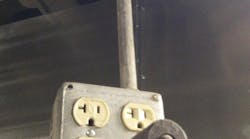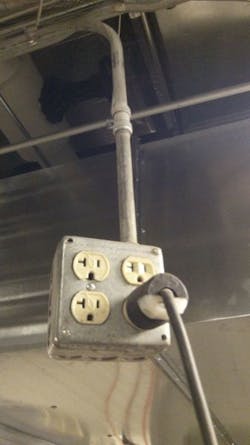How well do you know the Code? Think you can spot violations the original installer either ignored or couldn't identify? Here's your chance to moonlight as an electrical inspector and second-guess someone else's work from the safety of your living room or office. It's your turn to identify the violation.
Hint: Swingin' in the breeze
Find the Answer
I think it's just a matter of time until this box slips right off the pipe and shorts out the circuit. That's because it is dangling off the end of the pipe without any support. The added weight of the cord being plugged in could cause the compression couplings on the pipe to separate or the box connector to pull apart if they are not installed really tightly.
Section 314.23 lists several different methods for properly supporting boxes and other enclosures. Boxes can be supported with nails, screws, braces, framing members, support wires, and even RMC or IMC threaded into the box. Cord pendants are permitted in accordance with 314.23(H)(1), and threaded conduit pendants are recognized in 314.23(H)(2). However, an "EMT pendant" is not recognized as a Code-compliant method for supporting boxes. Whenever the cord is installed or removed from the receptacle, it would cause the box and pipe to move and swing back and forth. This continued movement could cause the fittings to loosen and result in a loss of equipment grounding, if the pipe is the only equipment grounding conductor. This loss of bonding/grounding could also lead to an increased shock hazard.





